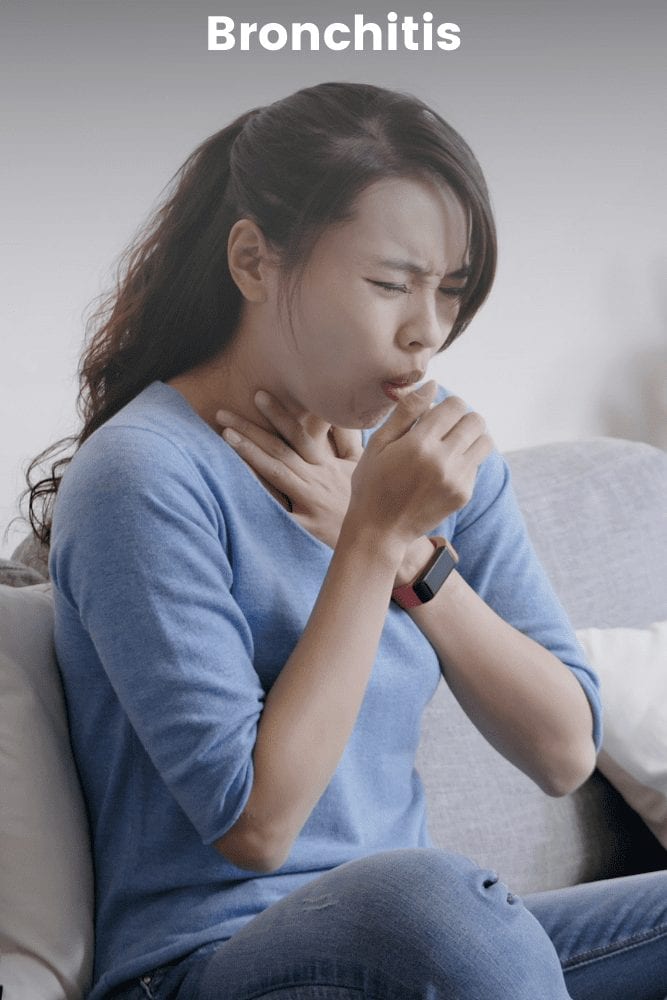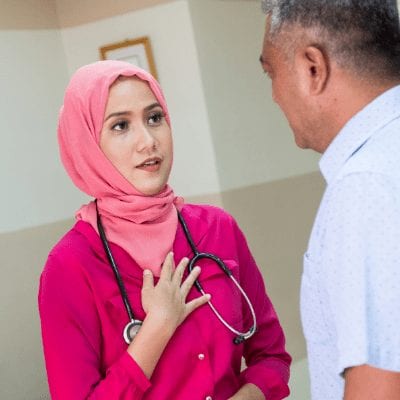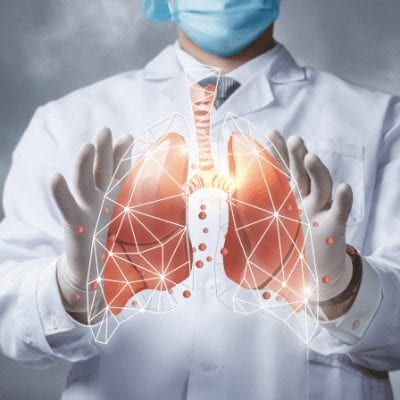An explanation of chronic cough conditions, what causes them, their symptoms and what treatment options you have in Malaysia.
An explanation of chronic cough conditions, what causes them, their symptoms and what treatment options you have in Malaysia.
However, when your cough is already non resolving after 2 weeks you need to start worrying, as you might be dealing with some lung problems.
Normal cough should resolve by itself within 1-3 days.
If the cough has been going on for a week, you need to see a doctor to determine whether you will need antibiotics to treat a possible bacterial infections in your lungs.
Some people who still have cough despite completion of antibiotics need to be further investigated to look for possible causes of the chronic cough.






















Asthma is a disease in which your airways narrow and swell and may produce extra mucus and secretions. This can cause breathing difficulty and trigger symptoms such as cough, whistling sound (wheezing) when you breathe out and shortness of breath.
For some people, asthma is a minor nuisance. For others, it can be a major problem that interferes with daily activities and may lead to a life-threatening asthma attack.
Asthma symptoms can be controlled, but unfortunately, it can’t be cured. Because asthma often changes from time to time, it’s important that you discuss with your doctor on how to track your signs and symptoms and adjust your treatment as needed.
Asthma occurs because of inflammation process that happens in the airway. It can get worse by infection and exposure to some stimuli or triggers
It isn’t clear why some people get asthma and others don’t, but it’s probably due to a combination of environmental and inherited (genetic) factors.
Asthma signs and symptoms include:
– Shortness of breath
– Chest tightness or pain
– Wheezing when exhaling, which is a common sign of asthma in children
– Trouble sleeping caused by shortness of breath, coughing or wheezing
– Coughing or wheezing attacks that are worsened by a respiratory virus, such as a cold or the flu.
Physical exam
Your lung doctor will perform a physical exam to rule out other possible conditions, such as a respiratory infection or chronic obstructive pulmonary disease (COPD).
Tests to measure lung function
You may be given lung function tests to determine how much air moves in and out as you breathe.
Prevention and long-term control are key to stopping asthma attacks before they start.
Treatment usually involves learning to recognize your triggers, taking steps to avoid triggers and tracking your breathing to make sure your medications are keeping symptoms under control.
In case of an asthma flare-up, you may need to use a quick-relief inhaler.

Chronic obstructive pulmonary disease (COPD) is a chronic inflammatory lung disease that causes obstructed airflow from the lungs. Symptoms include breathing difficulty, cough, mucus (sputum) production and wheezing.
It’s typically caused by long-term exposure to irritating gases or particulate matter, most often from cigarette smoke. People with COPD are at increased risk of developing heart disease, lung cancer and a variety of other conditions.
Although COPD is a progressive disease that gets worse over time, COPD is treatable. With proper management, most people with COPD can achieve good symptom control and quality of life, as well as reduced risk of other associated conditions.
The main cause of COPD in developed countries is tobacco smoking.
In the developing world, COPD often occurs in people exposed to fumes from burning fuel for cooking and heating in poorly ventilated homes.
Only some chronic smokers develop clinically apparent COPD, although many smokers with long smoking histories may develop reduced lung function.
Some smokers develop less common lung conditions. They may be misdiagnosed as having COPD until a more thorough evaluation is performed.
Signs and symptoms of COPD may include:
– Shortness of breath, especially during physical activities
– Wheezing
– Chest tightness
– A chronic cough that may produce mucus (sputum) that may be clear, white, yellow or greenish
– Frequent respiratory infections
– Lack of energy
– Unintended weight loss (in later stages)
– Swelling in ankles, feet or legs
There’s no single test for COPD. Diagnosis is based on symptoms, a physical exam, and diagnostic test results.
When you visit the doctor, be sure to mention all of your symptoms.
Treatment can relieve symptoms, prevent complications, and generally slow disease progression.
Your healthcare team may include a lung specialist (pulmonologist) and physical and respiratory therapists.

Pneumonia is an infection that affects the air sacs in one or both lungs. The air sacs may fill with fluid or pus (purulent material), causing cough with phlegm or pus, fever, chills, and difficulty breathing. A variety of organisms, including bacteria, viruses and fungi, can cause pneumonia.
Pneumonia can range in seriousness from mild to life-threatening. It is most serious for infants and young children, people older than age 65, and people with health problems or weakened immune systems.
Many germs can cause pneumonia. The most common are bacteria and viruses in the air we breathe. Your body usually prevents these germs from infecting your lungs. But sometimes these germs can overpower your immune system, even if your health is generally good.
Pneumonia is classified according to the types of germs that cause it and where you got the infection.
Signs and symptoms of pneumonia may include:
– Chest pain when you breathe or cough
– Confusion or changes in mental awareness (in adults age 65 and older)
– Cough, which may produce phlegm
– Fatigue
– Fever, sweating and shaking chills
– Lower than normal body temperature (in adults older than age 65 and people with weak immune systems)
– Nausea, vomiting or diarrhea
– Shortness of breath
Pneumonia can be diagnosed from medical history, physical examination, blood and sputum investigation and chest radiograph.
The doctor will start by asking about your medical history and doing a physical exam, including listening to your lungs with a stethoscope to check for abnormal bubbling or crackling sounds that suggest pneumonia.
Treatment for pneumonia includes curing the infection and preventing complications. People who have community-acquired pneumonia usually can be treated at home with medication. Although most symptoms ease in a few days or weeks, the feeling of tiredness can persist for a month or more.
Specific treatments depend on the type and severity of your pneumonia, your age and your overall health.

Tuberculosis (TB) is a contagious infection that usually attacks your lungs. It can also spread to other parts of your body, like your brain and spine.
A type of bacteria called Mycobacterium tuberculosis causes Tuberculosis.
Symptoms of active TB disease include:
– A cough that lasts more than 2 weeks
– Chest pain
– Coughing up blood
– Feeling tired all the time
– Night sweats
– Chills
– Fever
– Loss of appetite
– Weight loss
There are two common tests for tuberculosis:
– Skin test
– Blood test
Those tests don’t tell you if your infection is latent or active.
If you get a positive skin or blood test, your doctor will learn which type you have with:
– A chest X-ray or CT scan to look for changes in your lungs.
– Acid-fast bacillus (AFB) tests for TB bacteria in your sputum, the mucus that comes up when you cough
A combination of medicines are needed to treat active TB disease. You’ll take them for 6 to 12 months.
If you have drug-resistant TB, your doctor might give you one or more different medicines. You may have to take them for much longer, up to 30 months, and they can cause more side effects.
Whatever kind of infection you have, it’s important to finish taking all of your medications, even when you feel better. If you quit too soon, the bacteria can become resistant to the drugs

Lung cancer is a type of cancer that occurs in the lungs. The lung cancer can originate from the lungs, or it can also originate from other organs that subsequently spread to lungs.
Smoking causes the majority of lung cancers — both in smokers and in people exposed to secondhand smoke.
But lung cancer also occurs in people who never smoked and in those who never had prolonged exposure to secondhand smoke. In these cases, there may be no clear cause of lung cancer.
A number of factors may increase your risk of developing lung cancer. Some risk factors can be controlled, for instance, by quitting smoking. And other factors can’t be controlled, such as your family history and genetics.
Lung cancer typically doesn’t cause signs and symptoms in its earliest stages. Signs and symptoms of lung cancer typically occur when the disease is advanced.
Signs and symptoms of lung cancer may include:
– A new cough that doesn’t resolve
– Coughing up blood, even a small amount
– Shortness of breath
– Chest pain
– Hoarseness
– Losing weight without trying
– Bone pain
– Headache
People with an increased risk of lung cancer may consider annual lung cancer screening using low-dose CT scans. Lung cancer screening is generally offered to people 55 and older who smoked heavily for many years or who have quit in the past 15 years.
If there’s reason to think that you may have lung cancer, your doctor can order a number of tests to look for cancerous cells and to rule out other conditions.
Careful analysis of your cancer cells in a lab will reveal what type of lung cancer you have. Results of sophisticated testing can tell your doctor the specific characteristics of your cells that can help determine your prognosis and guide your treatment.
Cancer treatment plan is chosen based on a number of factors, such as your overall health, the type and stage of your cancer, and your preferences.
Treatment options may include:
– Surgery
– Radiation therapy
– Chemotherapy
– Stereotactic body radiotherapy
– Targeted drug therapy
– Immunotherapy
In some cases, you may choose not to undergo treatment. For example, you may feel that the side effects of treatment will outweigh the potential benefits. When that’s the case, your doctor may suggest comfort care to treat only the symptoms the cancer is causing, such as pain or shortness of breath.

Pleural Effusion, sometimes referred to as “water in the lungs,” is the build-up of excess fluid between the layers of the lung coverings (pleura) outside the lungs.
The pleura are thin membranes that line the lungs and the inside of the chest cavity and act to lubricate and facilitate breathing. Normally, a small amount of fluid is present in the pleura.
Pleural effusions may be either protein-poor (transudative) or protein-rich (exudative). These two categories will further determine the cause of the pleural effusion.
The most common causes of transudative (watery fluid) pleural effusions include:
– Heart failure
– Pulmonary embolism
– Cirrhosis
– Post open heart surgery
Exudative (protein-rich fluid) pleural effusions are most commonly caused by:
– Pneumonia
– Cancer
– Pulmonary embolism
– Kidney disease
– Inflammatory disease
Symptoms of pleural effusion includes:
– shortness of breath
– chest discomfort
– cough
The tests most commonly used to diagnose and evaluate pleural effusion include:
– Chest x-ray
– Computed tomography (CT) scan of the chest
– Ultrasound of the chest
– Thoracentesis (a needle is inserted between the ribs to remove a biopsy, or sample of fluid)
– Pleural fluid analysis (an examination of the fluid removed from the pleura space)
Treatment of pleural effusion is based on the underlying condition and whether the effusion is causing severe respiratory symptoms, such as shortness of breath or difficulty breathing.
Diuretics and other heart failure medications are used to treat pleural effusion caused by congestive heart failure or other medical causes.
A malignant effusion may also require treatment with chemotherapy, radiation therapy or a medication infusion within the chest.

Bronchitis is an infection of the main airways of the lungs (bronchi), causing them to become irritated and inflamed.
Bronchitis can be caused by various infectious agents, ranging from viral, bacterial and fungus.
The main symptom of bronchitis is a cough, which may produce yellow-grey mucus (phlegm).
Bronchitis may also cause a sore throat and wheezing.
You only need to see your doctor if your symptoms are severe or unusual – for example, if:
– your cough is severe or lasts longer than three weeks
– you have a constant fever (a temperature of 38°C – 100.4°F – or above) for more than three days
– you cough up mucus streaked with blood.
Diagnosis of bronchitis can be made from patient’s history taking and examination of the throat and lungs.
Most cases of bronchitis can be treated easily at home with rest, non-steroidal anti-inflammatory drugs (NSAIDs) and plenty of fluids. Usually it will resolve by itself if it was caused by viral infection.
However, if the bacterial infection is the cause, antibiotics will be needed.

Bronchiectasis is a disease in which there is permanent enlargement and dilatation of parts of the airways of the lung.
Bronchiectasis can be caused by various infectious and acquired causes, including pneumonia, tuberculosis, immune system problems, as well as the genetic disorder cystic fibrosis.
Symptoms typically include a chronic cough with mucus production.
Other symptoms include shortness of breath, coughing up blood, and chest pain. Wheezing and nail clubbing may also occur.
Those with the disease often get frequent lung infections.
The diagnosis is suspected based on symptoms and confirmed using computed tomography (CT) of the lungs.
Cultures of the mucus produced may be useful to determine source of infection.
Patient with bronchiectasis can have multiple bouts of infection. In these cases, antibiotics are recommended.
Airway clearance techniques, a type of physical therapy, are also recommended.
Medications to dilate the airways and inhaled steroids may be used during sudden worsening of the disease.
Surgery may be offered for patients who failed to respond to medical treatment.
Lung transplantation may be an option in those with very severe disease.

People with Hyperreactive Airway disease have bronchial tubes that overreact to some sort of irritant. The term is most commonly used to describe a person who is wheezing or having a bronchial spasm, but who has not yet been diagnosed with asthma.
There are some medical professionals who use the term in the same way they use the term asthma. The two are very similar. However, the term reactive airway disease is commonly used as a placeholder until the diagnosis of asthma can be made.
Hyperreactive airway disease, like asthma, occurs most often after you’ve had an infection.
It’s caused by some irritant that triggers the airways to overreact and swell or narrow.
Some causes or irritants may include:
• pet hair or dander
• dust
• pollen
• smoke
• mold or mildew
• exercise
• stress
• perfume or other strong odors
• changes in the weather
Sometimes, a combination of two or more irritants can cause a reaction, but those same irritants alone will not.
The symptoms of reactive airway disease are similar to those of asthma.
These symptoms may include:
• wheezing
• coughing
• shortness of breath or difficulty breathing
• excess mucus in the bronchial tube
• swollen mucous membrane in the bronchial tube
• hypersensitive bronchial tubes
Any time you have difficulty breathing and don’t know why, you should contact a medical professional immediately.
If you need surgery for any reason, let your medical team know about your breathing trouble.
Your anesthesiologist will need to make accommodations and take precautions if you are known to have any type of bronchial spasms.
Avoiding the irritants that trigger your symptoms is the best treatment.
However, avoiding the irritants is not always possible or practical.
The right treatment for you depends on your trigger and how severe your reactions to it are.
Some reactions can be controlled by allergy medications that should be taken regularly.
Other treatment options may include:
• using breathing and relaxation exercises (if your trigger is stress)
• treating an infection or virus
• using a rescue inhaler (effective for symptoms that are exercise-induced)

Bronchiolitis is a common lung infection in young children and infants.
It causes inflammation and congestion in the small airways (bronchioles) of the lung.
Bronchiolitis is almost always caused by a virus.
Typically, the peak time for bronchiolitis is during the rainy seasons.
Bronchiolitis occurs when a virus infects the bronchioles, which are the smallest airways in your lungs.
The infection makes the bronchioles swell and become inflamed. Mucus collects in these airways, which makes it difficult for air to flow freely in and out of the lungs.
Most cases of bronchiolitis are caused by the respiratory syncytial virus (RSV). RSV is a common virus that infects just about every child by 2 years of age.
Bronchiolitis also can be caused by other viruses, including those that cause the flu or the common cold.
The viruses that cause bronchiolitis are easily spread. You can contract them through droplets in the air when someone who is sick coughs, sneezes or talks.
You can also get them by touching shared objects — such as utensils, towels or toys — and then touching your eyes, nose or mouth.
For the first few days, the signs and symptoms of bronchiolitis are similar to those of a common cold:
• Runny nose
• Stuffy nose
• Cough
• Slight fever (not always present)
After this, there may be a week or more of difficulty breathing or a whistling noise when the child breathes out (wheezing).
Many infants also have an associated ear infection (otitis media).
If it’s difficult to get your child to eat or drink and his or her breathing becomes more rapid or labored, call your child’s doctor.
This is especially important if your child is younger than 12 weeks old or has other risk factors for bronchiolitis— including premature birth or a heart or lung condition.
The following signs and symptoms are reasons to seek urgent medical attention:
• Audible wheezing sounds
• Breathing very fast — more than 60 breaths a minute (tachypnea) — and shallowly
• Labored breathing — the ribs seem to suck inward when the infant inhales
• Sluggish or lethargic appearance
• Refusal to drink enough, or breathing too fast to eat or drink
• Skin turning blue, especially the lips and fingernails (cyanosis)
Because the viruses that cause bronchiolitis spread from person to person, one of the best ways to prevent it is to wash your hands frequently — especially before touching your baby when you have a cold or other respiratory illness.
Wearing a face mask at this time is appropriate.
If your child has bronchiolitis, keep him or her at home until the illness is past to avoid spreading it to others.
Other measures to help curb infection include:
• Limit contact with people who have a fever or cold. If your child is a newborn, especially a premature newborn, avoid exposure to people with colds, especially in the first two months of life.
• Clean and disinfect surfaces. Clean and disinfect surfaces and objects that people frequently touch, such as toys and doorknobs. This is especially important if a family member is sick.
• Cover coughs and sneezes. Cover your mouth and nose with a tissue. Then throw away the tissue and wash your hands or use alcohol-based hand sanitizer.
• Use your own drinking glass. Don’t share glasses with others, especially if someone in your family is ill.
• Wash hands often. Frequently wash your own hands and those of your child. Keep an alcohol-based hand sanitizer handy for yourself and your child when you’re away from home.
• Breast-feed. Respiratory infections are significantly less common in breast-fed babies.
There are no vaccines for the most common causes of bronchiolitis (RSV and rhinovirus). However, an annual flu shot is recommended for everyone older than 6 months.
Infants at high risk of the RSV infection, such as those born prematurely or with a heart or lung condition or who have a depressed immune system, may be given the medication palivizumab (Synagis) to decrease the likelihood of RSV infections.

Pulmonary Embolism (PE) is a blockage of main blood vessel (pulmonary artery) in the lungs by a substance that has moved from elsewhere in the body through the bloodstream (embolism).
The blockage of the main blood vessel can be caused by blood clots, cancerous mass, fat, air or amniotic fluid.
Symptoms of a PE may include shortness of breath, chest pain particularly upon breathing in, and coughing up blood.
Symptoms of a blood clot in the leg may also be present, such as a red, warm, swollen, and painful leg.
Signs of a PE include low blood oxygen levels, rapid breathing, rapid heart rate, and sometimes a mild fever.
Severe cases can lead to passing out, abnormally low blood pressure, and sudden death.
Diagnosis is based on signs and symptoms in combination with test results.
If the risk is low, a blood test known as a D-dimer may rule out the condition.
Otherwise, a CT pulmonary angiography, lung ventilation/perfusion scan, or ultrasound of the legs may confirm the diagnosis.
Together, deep vein thrombosis and PE are known as venous thromboembolism (VTE).
Treatment of pulmonary embolism is with anticoagulants such as heparin, warfarin or one of the direct-acting oral anticoagulants (DOACs).
These are recommended for at least three months.
Severe cases may require thrombolysis using medication such as tissue plasminogen activator (tPA) given intravenously or through a catheter, and some may require surgery (a pulmonary thrombectomy). If blood thinners are not appropriate, a temporary vena cava filter may be used.

Upon your first visit to the clinic we’ll conduct a thorough history taking, physical examination and lab investigation, to diagnose your actual lung disease quickly and accurately.

Choose the appropriate diagnostic plan and procedures such as Chest X Ray, CT scan, PET scan, Bronchoscopy, Pleuroscopy, Sleep study, TB, etc, to come to the correct diagnosis.

Working closely with my pharmacists, physiotherapists, or your personal physio, to suggest specific therapeutic options to allow the best and quickest relief from your condition.

Administer a customised treatment plan to suit your specific needs and effective recovery. Procedures may include: Anti-TB medications, inhalers, antibiotics, CPAP treatment, etc.
Schedule Your Appointment
Receive Diagnosis Report
Discuss Treatment Options

Consultant Respiratory & Internal Medicine Physician. MBBS, MRCP, Respiratory Medicine Fellowship, International Sleep Disorders Specialist.
Consultant Respiratory & Internal Medicine Physician. MBBS, MRCP, Respiratory Medicine Fellowship, International Sleep Disorders Specialist.
2B-12, Level 2, Sunway Velocity Medical Centre, Lingkaran SV, Sunway Velocity, 55100 Kuala Lumpur, Wilayah Persekutuan, Malaysia
Hospital: +603-9772-9191
Clinic: +603-9772-9365
Direct: +603-9772 9364

Signup to my newsletter to receive FREE Chest Health articles and information direct to your email.